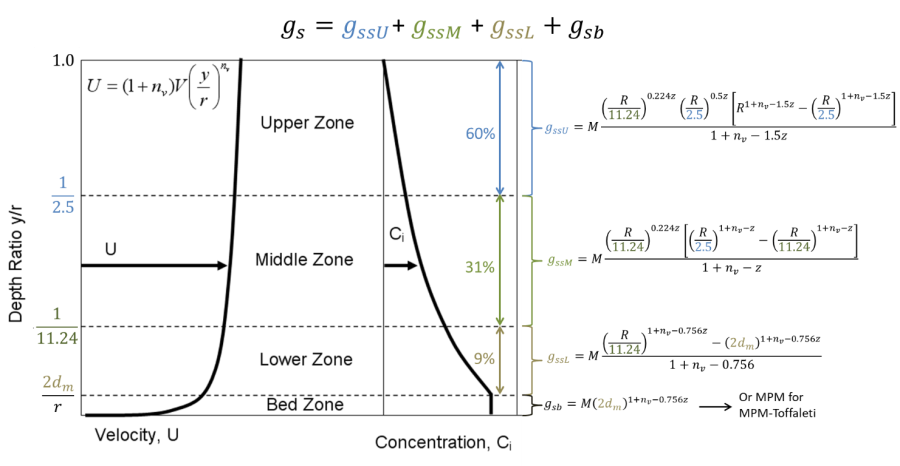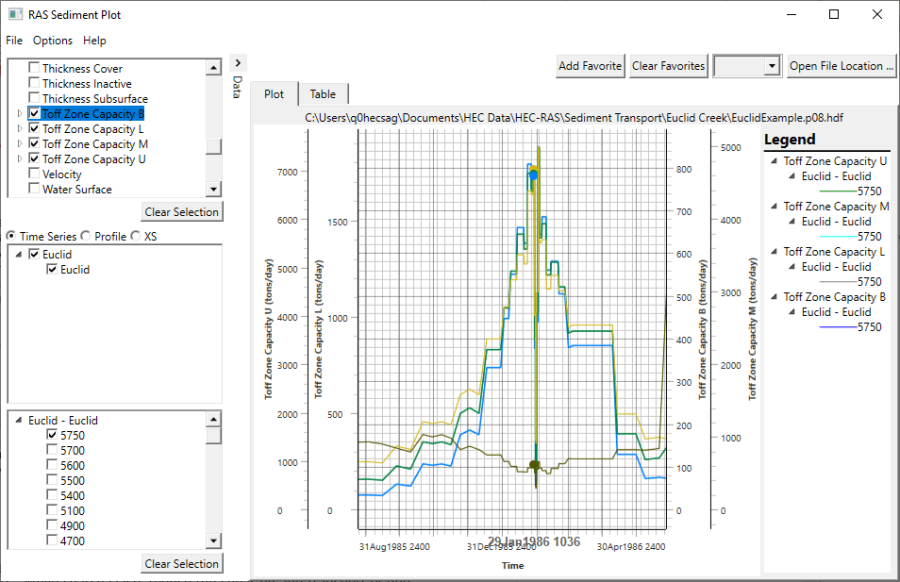Toffaleti (1968) is a total load function developed primarily for sand sized particles, which followed the basic principles of the Einstein approach, replacing some of the empirical assumptions. Toffaleti is usually applied to 'large rivers', since most of the data used to develop it were from large, suspended load systems. The function is not driven by excess shear velocity or bed shear. Instead, it describes the relationship between sediment, hydraulics, and water temperature with a set of regressions.
Toffaleti divides the water column down into four vertical zones and computes the concentration of each zone with a simple approximation of a Rouse concentration profile. The four zones are based on theoretical inflection points and transitions in the vertical velocity profile. The function then computes transport in each of the zones (see figure below) based on a "reference unit sediment discharge" (Mi):
|
M_i = \frac {G_{ss} \left(1+n_v-0.756z_i\right)}{\left( \frac{R}{11.24}\right)^{1+n_v-0.756z_i} - \left(2d_{si}\right)^{1+n_v-0.756z_i}} |
Where gssLi is the "nucleus load"
|
g_{ssLi} = \frac{0.600p_i}{\left( \frac{T_T Ak_4}{V^2}\right)^{\frac53} \left( \frac{d_{si}}{0.00058}\right)^{\frac53}} |
and the two exponents are:
|
z_i = \frac{\omega V}{(260.67 - 0.667T)rS} \vspace{3} n_v = 0.1198 + 0.000048T |
In these equations, T is temperature, V is the 1D, depth averaged water velocity, r is the full, average water depth, S is the river slope, dsi and wi are the particle size and fall velocity of the particular grain class (i) and pi is the fraction of that grain class. Because of the dimensionality of this equation, all units are US customary, and HEC-RAS converts SI units before and after calculating Toffaleti transport.

Modeling Note: Toffaleti temperature sensitivity
Temperature appears in both the z and nv exponents, which can make Toffaleti more sensitive to temperature than excess shear equations.
The USACE has applied the function successfully to large systems like the Mississippi, Arkansas, Sacramento, and the Atchafalaya Rivers. However, it performs particularly poorly for gravel size particles. Additionally, the Toffaleti equation uses two different grain sizes, a d50 and a d65, to quantify transport dependence on the gradational deviation from the mean. This made more sense when the equation was used to compute the transport of the bulk gradational material. When HEC-RAS applies it to the individual grain classes, it will use the d50 and d65 for the given grain class, stretching the original intent of the d65 parameter.
HEC-RAS can output transport for each zone separately, approximating the vertical concentration profile. Sometimes modelers will use this feature to calibrate to suspended load measurements, comparing the measurement to the computed flux from the upper three zones.
